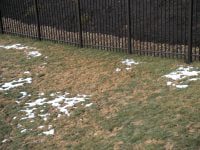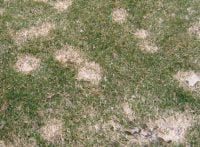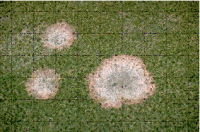Is my lawn dying, or is it snow mold?
After the snow melts, you may find that your lawn is riddled with circles or patches of dead-looking grass. It may be gray, tan, white, or even pink. It could be that the grass is dead due to extremely severe winter conditions, or late fall damage by grubs or crane fly larvae, but it is most likely that you have snow mold.

Snow mold is a lawn diseases that is usually related to winter conditions and snow cover, either too little or too much. It is encouraged when grass is left too long over the winter, and when nutrients and trace elements are lacking. Thatch conditions are also going to promote snow mold. If you over-fertilize in the fall, or time it wrong, you can cause too much tender late fall growth and this encourages snow mold too.
Some grasses are more susceptible to snow mold, but all grass types can get it. A properly mowed and watered, deep-rooted lawn, growing in a bio-active and nutritionally balanced soil is your best defense against snow mold.
There are two types of snow mold: gray snow mold, or the more severe pink snow mold. Both of these diseases will appear as circular dead patches, often 3 -12 inches in diameter. Sometimes it is so severe that the patches all join together and cover most of the lawn. Upon closer inspection you might see fuzzy webbing or strands (mycelium) on top of the grass blades or at the very edges of the damaged spot.
 Gray snow mold damage is less severe than that of pink snow mold. The damage is primarily to the leaf blades of the grass only. Once lawns start to green up in the spring and temperatures are staying in the mid 40s and above day and night, further damage to the lawn usually ceases. The mycelium will quickly dry out and and will be hard to find. The lawn will usually recover if it is healthy and deeply rooted.
Gray snow mold damage is less severe than that of pink snow mold. The damage is primarily to the leaf blades of the grass only. Once lawns start to green up in the spring and temperatures are staying in the mid 40s and above day and night, further damage to the lawn usually ceases. The mycelium will quickly dry out and and will be hard to find. The lawn will usually recover if it is healthy and deeply rooted.
TREATMENT FOR GRAY SNOW MOLD
The best thing you can do for gray snow mold, aside from improving your soil aeration and bioactivity (we recommend using Aerify PLUS soil conditioner), is to lightly fluff up the dead grass with a rake. This will allow it to dry more completely and will also allow the sunlight to reach the soil and promote new grass growth. A light fertilizing after the rest of the grass starts to green up may help recovery too. Use our LAWN FORCE 5 if you have it, or any fast acting fertilizer. Again, go light at this time. In the fall, make sure you cut short at the end of the year and handle any thatch during the season.

Pink snow mold remains active much longer than gray snow mold. It can continue to grow until temperatures get into the low 60’s. You will find pink/salmon colored mycelium at the outer edges. You can see this easily in the morning when there is dew on the ground. Pink snow mold damages the blades as well as the crowns of the grass. When the crowns (where both the blades and the roots emanate from) are damaged, the grass may not recover.
Southern lawns can get pink snow mold, especially on golf course greens. All you need are temperatures in the low 30s and damp conditions.
As with the gray snow mold, you should lightly rake or fluff up the pink snow mold to allow air and sunlight to get to the soil. With this type you should be careful to not spread the disease by using the rake on the rest of the lawn. After you rake the pink snow mold you should clean your rake with some alcohol or an anti-bacterial soap.
Pink snow mold eventually stops on its own when temperatures are high enough. At that time it is a simple enough matter to simply spot seed the damaged areas.
TREATMENT FOR PINK SNOW MOLD
Liquid Kelp (seaweed) and Humic Acid (bio-active carbon) contain numerous trace elements and bio-stimulants that can help a lawn recover from snow mold quickly. Using one or the other or both will provide benefits to the soil as well as the grass. Spraying liquid forms of these will work much quicker than applying powdered forms. A late fall application may work as a preventative, too. Nature’s Magic is a 50/50 blend of these two amendments.
Compost Tea and Earthworm Castings Teas have been shown to help reduce most lawn diseases. A simple verison of how to make this tea to cover a large area of lawn would be to take a cup of compost or earthworm castings (you can usually find each in nurseries) and soak them for 24-36 hours in a five gallon bucket filled 2/3 or so with water. Stir often to get some air in the water or use an aerating device if you have one. Then simply strain and put the tea in a watering can or sprayer and soak the snow mold and the grass right around it.
Something else to try would be hydrogen peroxide– 1 cup in 2 gallons of water 2 or 3 times, perhaps 5 days apart. If it doesn’t kill the snow mold it should keep it from spreading. If you have any cedar-based Yard Guard, that has anti-fungal properties so you can spray that on the snow mold in the same way as the hydrogen peroxide.
That’s all for now! As always, feel free to email us with questions about our products at [email protected] .